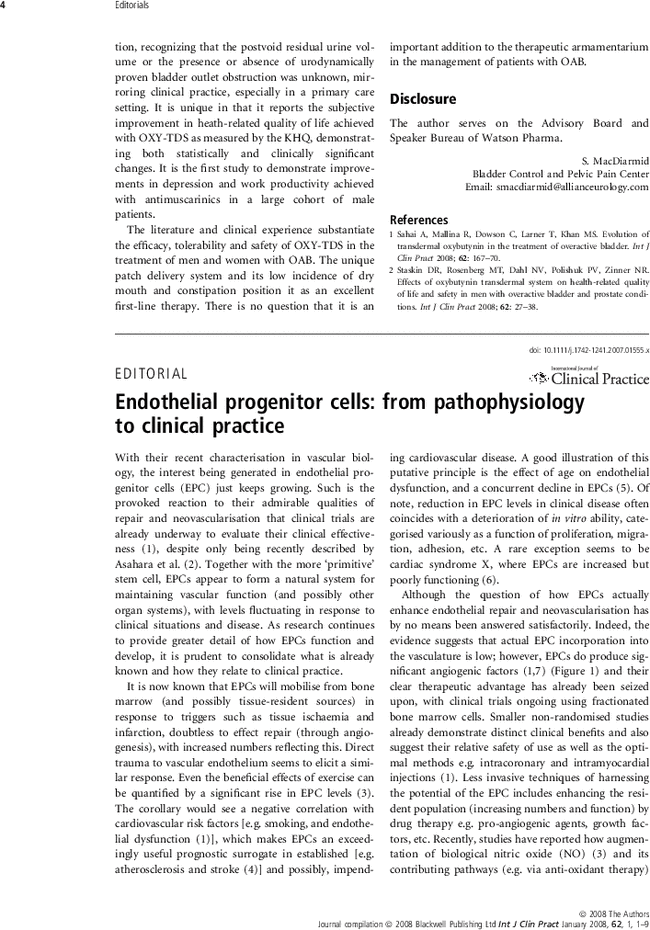Endothelial progenitor cells: from pathophysiology to clinical practice
P. K. Y. Goon
Haemostasis, Thrombosis and Vascular Biology Unit, University Department of Medicine, City Hospital, Birmingham B18 7QH, England, UKEmail: [email protected]
Search for more papers by this authorT. Watson
Haemostasis, Thrombosis and Vascular Biology Unit, University Department of Medicine, City Hospital, Birmingham B18 7QH, England, UKEmail: [email protected]
Search for more papers by this authorP. S. Stonelake
Haemostasis, Thrombosis and Vascular Biology Unit, University Department of Medicine, City Hospital, Birmingham B18 7QH, England, UKEmail: [email protected]
Search for more papers by this authorG. Y. H. Lip
Haemostasis, Thrombosis and Vascular Biology Unit, University Department of Medicine, City Hospital, Birmingham B18 7QH, England, UKEmail: [email protected]
Search for more papers by this authorP. K. Y. Goon
Haemostasis, Thrombosis and Vascular Biology Unit, University Department of Medicine, City Hospital, Birmingham B18 7QH, England, UKEmail: [email protected]
Search for more papers by this authorT. Watson
Haemostasis, Thrombosis and Vascular Biology Unit, University Department of Medicine, City Hospital, Birmingham B18 7QH, England, UKEmail: [email protected]
Search for more papers by this authorP. S. Stonelake
Haemostasis, Thrombosis and Vascular Biology Unit, University Department of Medicine, City Hospital, Birmingham B18 7QH, England, UKEmail: [email protected]
Search for more papers by this authorG. Y. H. Lip
Haemostasis, Thrombosis and Vascular Biology Unit, University Department of Medicine, City Hospital, Birmingham B18 7QH, England, UKEmail: [email protected]
Search for more papers by this authorHow EPCs actually enhance endothelial repair and neovascularisation has not been answered satisfactorily. EPCs appear to be a predictor of cardiovascular function and state, and a significant mediator driving enhanced endothelial function and increased blood supply via neovascularisation

References
- 1 Shantsila E, Watson T, Lip GYH. Endothelial progenitor cells in cardiovascular disorders. J Am Coll Cardiol 2007; 49: 741–52.
- 2 Asahara T, Murohara T, Sullivan A et al. Isolation of putative progenitor endothelial cells for angiogenesis. Science 1997; 275: 964–7.
- 3 Yang Z, Wang JM, Chen L, Luo CF, Tang AL, Tao J. Acute exercise-induced nitric oxide production contributes to upregulation of circulating endothelial progenitor cells in healthy subjects. J Hum Hypertens 2007; 21: 452–60.
- 4 Lau KK, Chan YH, Yiu KH et al. Burden of carotid atherosclerosis in patients with stroke: relationships with circulating endothelial progenitor cells and hypertension. J Hum Hypertens 2007; 21: 445–5.
- 5 Boos CJ, Goon PK, Lip GY. Endothelial progenitor cells in the vascular pathophysiology of hypertension: arterial stiffness, ageing and more. J Hum Hypertens 2006; 20: 475–7.
- 6 Goon PK, Lip GY. Endothelial progenitor cells, endothelial cell dysfunction and much more: observations from cardiac syndrome X. Heart 2007; 93: 1020–1.
- 7 Urbich C, Aicher A, Heeschen C et al. Soluble factors released by endothelial progenitor cells promote migration of endothelial cells and cardiac resident progenitor cells. J Mol Cell Cardiol 2005; 39: 733–42.
- 8 Tao J, Yang Z, Wang JM et al. Shear stress increases Cu/Zn SOD activity and mRNA expression in human endothelial progenitor cells. J Hum Hypertens 2007; 21: 353–8.
- 9 Shantsila E, Watson T, Lip GY. Antioxidant protection: yet another function of endothelial progenitor cells? J Hum Hypertens 2007; 21: 343–6.
- 10 Aicher A, Heeschen C, Mildner-Rihm C et al. Essential role of endothelial nitric oxide synthase for mobilization of stem and progenitor cells. Nat Med 2003; 9: 1370–6.
- 11 Yoon YS, Wecker A, Heyd L et al. Clonally expanded novel multipotent stem cells from human bone marrow regenerate myocardium after myocardial infarction. J Clin Invest 2005; 115: 326–38.
- 12 Goon PK, Lip GY, Boos CJ, Stonelake PS, Blann AD. Circulating endothelial cells, endothelial progenitor cells, and endothelial microparticles in cancer. Neoplasia 2006; 8: 79–88.
- 13 Jain RK. Normalization of tumor vasculature: an emerging concept in antiangiogenic therapy. Science 2005; 307: 58–62.
- 14 Wei YQ, Wang QR, Zhao X et al. Immunotherapy of tumors with xenogeneic endothelial cells as a vaccine. Nat Med 2000; 6: 1160–6.
- 15 Davidoff AM, Ng CY, Brown P et al. BM-derived cells contribute to tumor neovasculature and, when modified to express an angiogenesis inhibitor, can restrict tumor growth in mice. Clin Cancer Res 2001; 7: 2870–9.
- 16 Romagnani P, Annunziato F, Liotta F et al. CD14 + CD34 low cells with stem cell phenotypic and functional features are the major source of circulating endothelial progenitors. Circ Res 2005; 97: 314–22.




